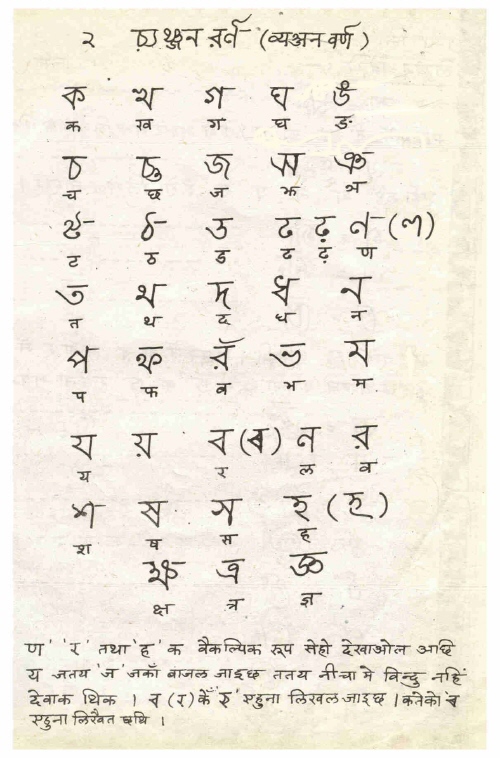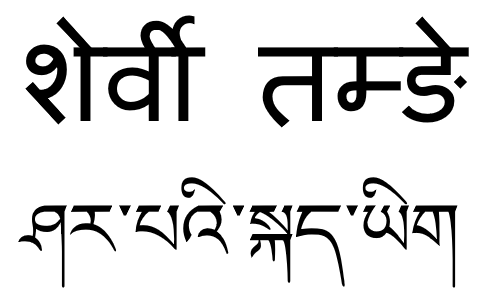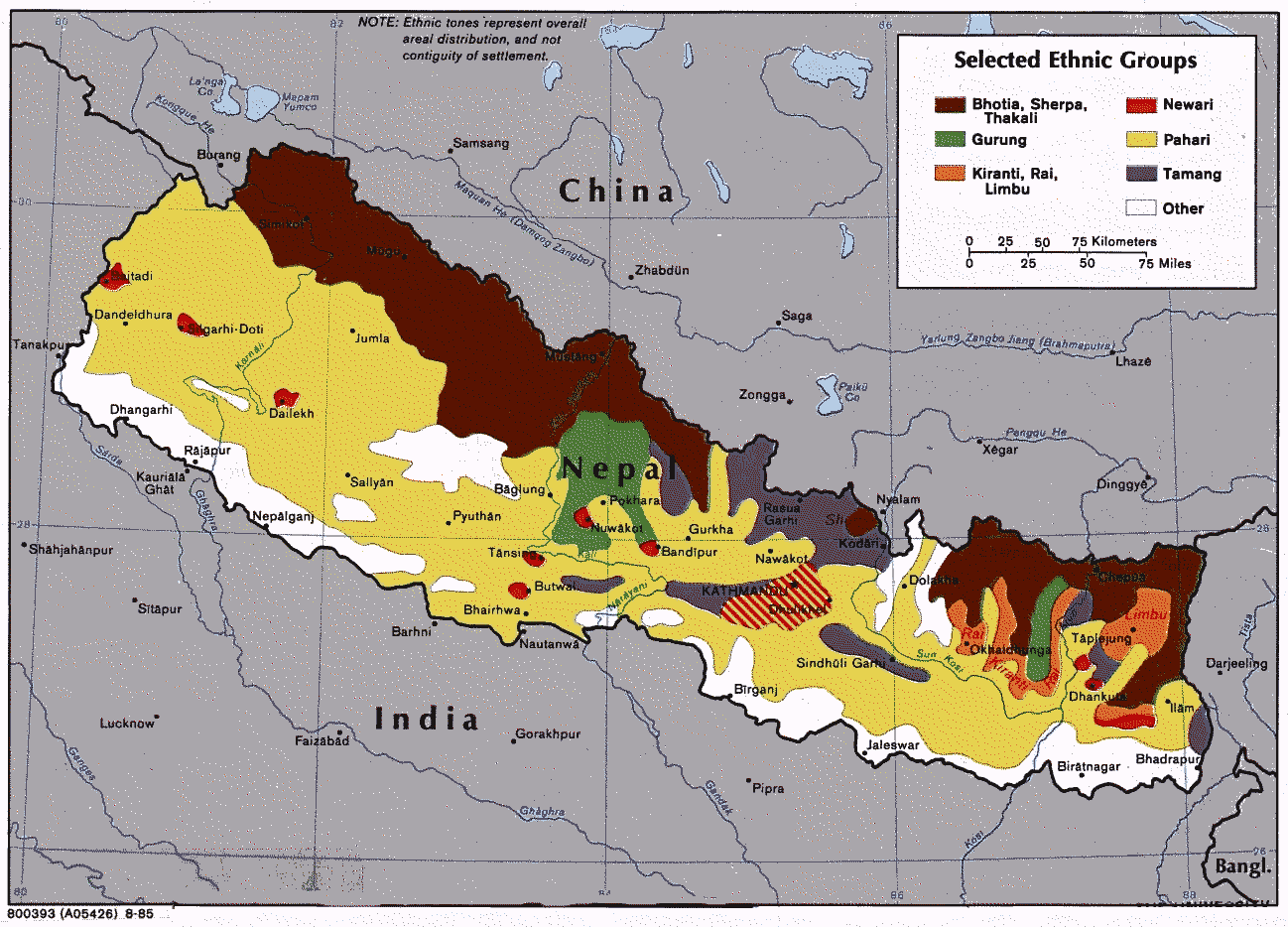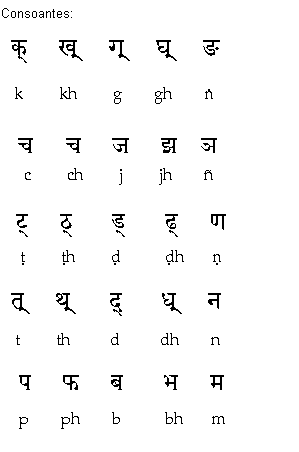|
Kalinchowk Rural Municipality
Kalinchowk is a Rural municipality located within the Dolakha district of the Bagmati province of Nepal. The municipality spans of area, with a total population of 22,954 according to a 2011 Nepal census. On March 10, 2017, the Government of Nepal restructured the local level bodies into 753 new local level structures. The previous Kalinchowk, Babare, Lamidanda, Lapilang, Sunakhani, and Sundrawati VDCs were merged to form Kalinchowk Rural Municipality. Kalinchowk is divided into 9 wards, with Sunakhani declared the administrative center of the rural municipality. Kalinchowk is a hill station and a tourist hotspot. It is located at 3842 meters of altitude and about 150km northeast from national capital Kathmandu. The place is best known for trekking and skiing. During the December, January and February (mainly Paush and Magh in Nepali months) snowfalls in Kalinchowk. Demographics At the time of the 2011 Nepal census, Kalinchowk Rural Municipality had a population of 22,954. Of ... [...More Info...] [...Related Items...] OR: [Wikipedia] [Google] [Baidu] |
Rural Municipality
A rural municipality is a classification of municipality, a type of local government, found in several countries. These include: * Rural municipality (Canada), Rural municipalities in Canada, a Lists of municipalities in Canada, type of municipality, municipal status in the Canada, Canadian provinces of Manitoba, Saskatchewan, and Prince Edward Island. In other provinces, such as Alberta and Nova Scotia, the term refers to municipal districts that are not explicitly urban, rather than being a distinct type of municipality. * Municipalities of Estonia, Rural municipalities in Estonia, also called Parish (administrative division), parishes, of which there are 64 in the country. Municipalities may contain one or several Populated places in Estonia, settlements, and while all urban municipalities contain only one settlement, only 6 rural municipalities do. Of these, five are so-called "borough-parishes", consisting of one borough, while Ruhnu Parish consists of one village. *Gaunpalik ... [...More Info...] [...Related Items...] OR: [Wikipedia] [Google] [Baidu] |
Lapilang
Lapilang is a village development committee in Dolakha District in the Janakpur Zone of north-eastern Nepal Nepal (; ne, नेपाल ), formerly the Federal Democratic Republic of Nepal ( ne, सङ्घीय लोकतान्त्रिक गणतन्त्र नेपाल ), is a landlocked country in South Asia. It is mai .... At the time of the 1991 Nepal census it had a population of 3,959 people living in 901 individual households.. References External linksUN map of the municipalities of Dolakha District Populated places in Dolakha District {{Dolakha-geo-stub ... [...More Info...] [...Related Items...] OR: [Wikipedia] [Google] [Baidu] |
Majhi Language
Majhi is an Indo-Aryan language spoken in parts of Nepal and formerly in some small pockets of neighboring India.:1 The language is associated with the Majhi people, an ethnic group in those regions who dwell historically near the Saptakoshi River and its tributaries and elsewhere in central and eastern Nepal. The Majhi people generally subsist off of work associated with rivers, including fishing and ferrying.:2 Majhi is written using the Devanagari writing system. Ethnologue classifies Mahji as a 6b threatened language. There are roughly 24,400 L1 speakers of Majhi in Nepal and roughly 46,120 L1 and L2 speakers of the language around the globe. Most of the Majhi speakers in Nepal are bilingual with the more predominant Nepali language,:2 and the latter language is replacing Majhi in use. Majhi's lack of official status, use in education, in media, in print, etc. places the survival of the language in a precarious position.:2 The last speaker in India, Thak Bahadur Majhi of Jor ... [...More Info...] [...Related Items...] OR: [Wikipedia] [Google] [Baidu] |
Maithili Language
Maithili () is an Indo-Aryan language spoken in parts of Languages of India, India and Languages of Nepal, Nepal. It is native to the Mithila region, which encompasses parts of the Indian states of Bihar and Jharkhand as well as Nepal's eastern Terai. It is one of the 22 Eighth Schedule to the Constitution of India, officially recognised languages of India and the second most spoken Languages of Nepal, Nepalese language in Nepal. The language is predominantly written in Devanagari, but there were two other historically important scripts: Tirhuta script, Tirhuta, which has retained some use until the present, and Kaithi script, Kaithi. Official status In 2003, Maithili was included in the 8th Schedule, Eighth Schedule of the Indian Constitution as a recognised language of India, Indian language, which allows it to be used in education, government, and other official contexts in India. Maithili language is included as an optional paper in the Union Public Service Commission, UP ... [...More Info...] [...Related Items...] OR: [Wikipedia] [Google] [Baidu] |
Magar Language
Magar Dhut ( ne, मगर ढुट, ) is a Sino-Tibetan Language spoken mainly in Nepal, Southern Bhutan, and in Darjeeling and Sikkim, India, by the Magar people. It is divided into two groups (Eastern and Western) and further dialect divisions give distinct tribal identity. In Nepal 788,530 people speak the language. While the government of Nepal developed Magar language curricula, as provisioned by the constitution, the teaching materials have never successfully reached Magar schools, where most school instruction is in the Nepali language. It is not unusual for groups with their own language to feel that the "mother-tongue" is an essential part of identity. The Dhut Magar language is sometimes lumped with the Magar Kham language spoken further west in Bheri, Dhaulagiri, and Rapti zones. Although the two languages share many common words, they have major structural differences and are not mutually intelligible. Geographical distribution Western Magar Western Magar ... [...More Info...] [...Related Items...] OR: [Wikipedia] [Google] [Baidu] |
Sherpa Language
Sherpa (also Sharpa, Xiaerba, or Sherwa) is a Tibetic language spoken in Nepal and the Indian state of Sikkim, mainly by the Sherpa. The majority speakers of the Sherpa language live in the Khumbu region of Nepal, spanning from the Chinese (Tibetan) border in the east to the Bhotekosi River in the west. About 200,000 speakers live in Nepal (2001 census), some 20,000 in Sikkim (1997) and some 800 in Tibetan Autonomous Region (1994). Sherpa is a subject-object-verb (SOV) language. Sherpa is predominantly a spoken language, although it is occasionally written using either the Devanagari or Tibetan script. Phonology Sherpa is a tonal language. Sherpa has the following consonants: Consonants * Stop sounds can be unreleased in word-final position. * Palatal sounds can neutralize to velar sounds when preceding . * can become a retroflex nasal when preceding a retroflex stop. * can have an allophone of when occurring in fast speech. Vowels * Vowel sounds have the ... [...More Info...] [...Related Items...] OR: [Wikipedia] [Google] [Baidu] |
Newar Language
Newar (), or Newari and known officially in Nepal as Nepal Bhasa, is a Sino-Tibetan language spoken by the Newar people, the indigenous inhabitants of Nepal Mandala, which consists of the Kathmandu Valley and surrounding regions in Nepal. "Nepal Bhasa" literally means "Nepalese language", however the language is not the same as Nepali (Devanāgarī: नेपाली), the country's current official language of the central government. The two languages belong to different language families (Sino-Tibetan and Indo-European, respectively), but centuries of contact have resulted in a significant body of shared vocabulary. Newar was Nepal's administrative language from the 14th to the late 18th century. From the early 20th century until democratisation, Newar suffered from official suppression. From 1952 to 1991, the percentage of Newar speakers in the Kathmandu Valley dropped from 75% to 44% and today Newar culture and language are under threat. The language has been listed ... [...More Info...] [...Related Items...] OR: [Wikipedia] [Google] [Baidu] |
Tamang Language
Tamang (Devanagari: तामाङ; ''tāmāng'') is a term used to collectively refer to a dialect cluster spoken mainly in Nepal, Sikkim, West Bengal (Darjeeling) and North-Eastern India. It comprises Eastern Tamang, Northwestern Tamang, Southwestern Tamang, Eastern Gorkha Tamang, and Western Tamang. Lexical similarity between Eastern Tamang (which is regarded as the most prominent) and other Tamang languages varies between 81% to 63%. For comparison, lexical similarity between Spanish and Portuguese, is estimated at 89%. Ethnologue report for Spanish Dialects ''Ethnologue'' divides Tamang into the following varieties due to mutual unintelligibility. *Eastern Tamang: 759,000 in Nepal (2000 WCD). Population total all countries: 773,000. Sub-dialects are as follows. **Outer-Eastern Tamang (Sailung Tamang) **Central-Eastern Tamang (Temal Tamang) **Southwestern Tamang (Kath-Bhotiya, Lama Bhote, Murmi, Rongba, Sain, Tamang Gyoi, Tamang Gyot, Tamang Lengmo, Tamang Tam) *Western T ... [...More Info...] [...Related Items...] OR: [Wikipedia] [Google] [Baidu] |
Thangmi Language
Thangmi, also called Thāmī, Thangmi Kham, Thangmi Wakhe, and Thani, is a Sino-Tibetan language spoken in central-eastern Nepal and northeastern India by the Thami people. The Thami refer to their language as ''Thangmi Kham'' or ''Thangmi Wakhe'' while the rest of Nepal refers to it as ''Thāmī''. The majority of these speakers, however, live in Nepal in their traditional homeland of Dolakhā District. In India, the Thami population is concentrated mostly in Darjeeling. The Thangmi language is written using the Devanagari script. Thangmi has been extensively documented by Mark Turin. Distribution Thangmi is spoken in Bagmati Province, mainly in the region of Dolakha; villages on Sailung Khola (The northern panhandle of the Ramechhap District; mainly in Gokulganga); eastern regions of Sindhupalchowk District; and by some elders among the population who migrated to the cities in the Kathmandu Valley. Very few ethnic Thami outside Dolakha and Sindhupalcok districts speak Than ... [...More Info...] [...Related Items...] OR: [Wikipedia] [Google] [Baidu] |
Nepali Language
Nepali (; , ) is an Indo-Aryan language native to the Himalayas region of South Asia. It is the official, and most widely spoken, language of Nepal, where it also serves as a '' lingua franca''. Nepali has official status in the Indian state of Sikkim and in the Gorkhaland Territorial Administration of West Bengal. It is spoken by about a quarter of Bhutan's population. Nepali also has a significant number of speakers in the states of Arunachal Pradesh, Assam, Himachal Pradesh, Manipur, Meghalaya, Mizoram and Uttarakhand. In Myanmar it is spoken by the Burmese Gurkhas. The Nepali diaspora in the Middle East, Brunei, Australia and worldwide also use the language. Nepali is spoken by approximately 16 million native speakers and another 9 million as a second language. Nepali is commonly classified within the Eastern Pahari group of the Northern zone of Indo-Aryan. The language originated from the Sinja Valley, Karnali Province then the capital city of the Khasa K ... [...More Info...] [...Related Items...] OR: [Wikipedia] [Google] [Baidu] |
Kathmandu
, pushpin_map = Nepal Bagmati Province#Nepal#Asia , coordinates = , subdivision_type = Country , subdivision_name = , subdivision_type1 = Province , subdivision_name1 = Bagmati Province , subdivision_type2 = District , subdivision_name2 = Kathmandu , established_title = , founder = Manjushri , parts_type = No. of Wards , parts = 32 , seat_type = , seat = , government_footnotes = , government_type = Mayor–council government , governing_body = Kathmandu Metropolitan Government, , leader_title = Mayor , leader_name = Balendra Shah ( Ind.) , leader_title1 = Deputy mayor , leader_name1 = Sunita Dangol (UML) , leader_title2 = Executive Officer , leader_name2 = Basanta Adhikari , unit_pref ... [...More Info...] [...Related Items...] OR: [Wikipedia] [Google] [Baidu] |
Ward (electoral Subdivision)
A ward is a local authority area, typically used for electoral purposes. In some countries, wards are usually named after neighbourhoods, thoroughfares, parishes, landmarks, geographical features and in some cases historical figures connected to the area (e.g. William Morris Ward in the London Borough of Waltham Forest, England). It is common in the United States for wards to simply be numbered. Origins The word “ward”, for an electoral subdivision, appears to have originated in the Wards of the City of London, where gatherings for each ward known as “wardmotes” have taken place since the 12th century. The word was much later applied to divisions of other cities and towns in England and Wales and Ireland. In parts of northern England, a ''ward'' was an administrative subdivision of a county, very similar to a hundred in other parts of England. Present day In Australia, Canada, New Zealand, Sri Lanka, South Africa, the United Kingdom, and the United States, wards are an ... [...More Info...] [...Related Items...] OR: [Wikipedia] [Google] [Baidu] |







